Panasonic CT-36SX31CE, CT-32SX31UE, CT-36SX31E, CT-32SX31E, CT-36SX31UE User Manual
...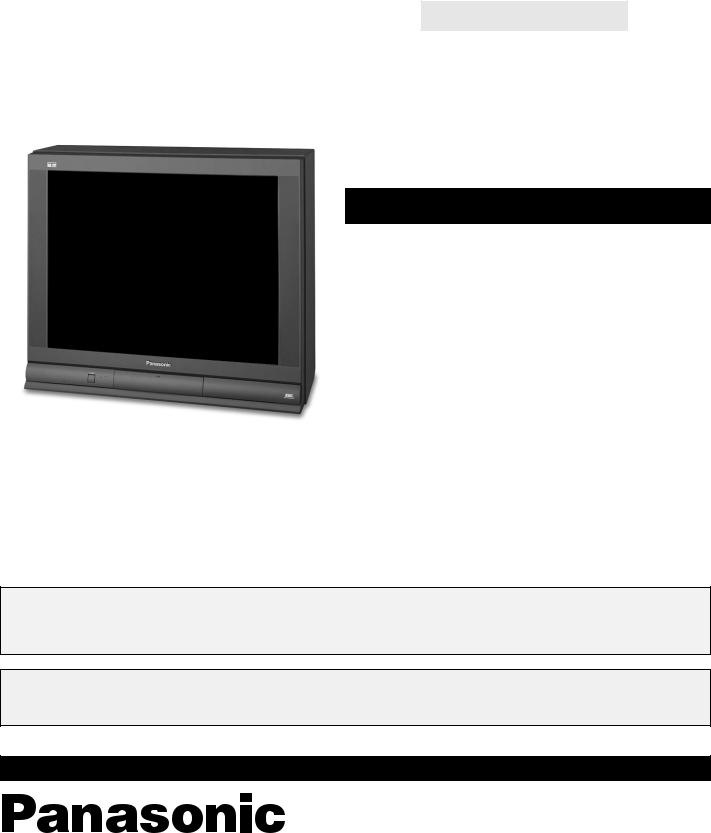
ORDER NO. MTNC010524C1
B5
Service Manual
Color Television
Main Manual
(NA8ML)
Panasonic
Models Chassis
CT-32SX31E BP371
CT-32SX31UE BP371
CT-32SX31CE BP371
CT-36SX31E BP372
CT-36SX31UE BP372
CT-36SX31CE BP372
This Service manual is issued as a service guide for the models of the NA8ML family listed above. Included in this manual are a set of schematic, block diagrams, functional descriptions, alignment procedures, disassembly procedures and a complete parts list.
“WARNING! This Service Manual is designed for experienced repair technicians only and is not designed for use by the general public. It does not contain warnings or cautions to advise non-technical individuals of potential dangers in attempting to service a product.
Products powered by electricity should be serviced or repaired only by experienced professional technicians. Any attempt to service or repair the product or products dealt with in this Service Manual by anyone else could result in serious injury or death.”
The service technician is required to read and follow the “Safety Precautions” and “ Important Safety Notice” in this Main Manual.
|
Copyright 2001 by Matsushita Electric Corporation of |
|
America. All rights reserved. Unauthorized copying |
® |
and distribution is a violation of law. |
|
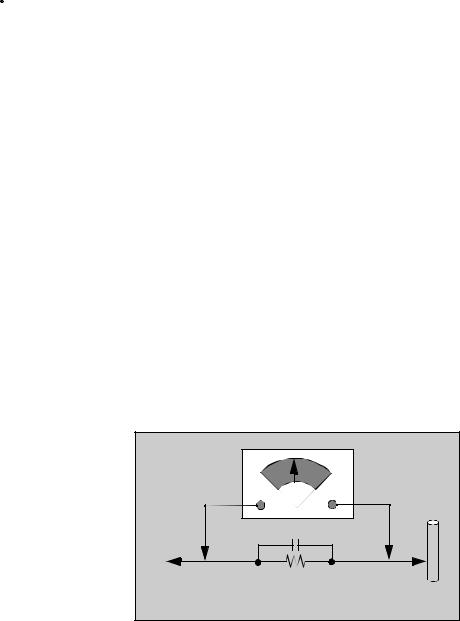
Important Safety Notice
Special components are used in this television set which are important for safety. These parts are identified on the schematic diagram by the symbol  and printed in BOLD TYPE on the replacement part list. It is essential that these critical parts are replaced with the manufacturer’s specified replacement part to prevent X-ray radiation, shock, fire or other hazards. Do not modify the original design without the manufacturer’s permission.
and printed in BOLD TYPE on the replacement part list. It is essential that these critical parts are replaced with the manufacturer’s specified replacement part to prevent X-ray radiation, shock, fire or other hazards. Do not modify the original design without the manufacturer’s permission.
Safety Precautions
General Guidelines
An Isolation Transformer should always be used during the servicing of a receiver whose chassis is not isolated from AC power line. Use a transformer of adequate power rating as this protects the technician from accidents resulting in personal injury from electrical shocks. It will also protect the Receiver from being damaged by accidental shorting that may occur during servicing.
When servicing, observe the original lead dress, especially in the high voltage circuit. Replace all damaged parts (also parts that show signs of overheating.)
Always Replace Protective Devices, such as fishpaper, isolation resistors and capacitors, and shields after servicing the Receiver. Use only manufacturer’s recommended rating for fuses, circuits breakers, etc.
High potentials are present when this Receiver is operating. Operation of the Receiver without the rear cover introduces danger for electrical shock. Servicing should not be performed by anyone who is not thoroughly familiar with the necessary precautions when servicing high-voltage equipment.
Extreme care should be practiced when Handling the Picture Tube. Rough handling may cause it to implode due to atmospheric pressure. (14.7 lbs per sq. in.). Do not nick or scratch the glass or subject it to any undue pressure. When handling, use safety goggles and heavy gloves for protection. Discharge the picture tube by shorting the anode to chassis ground (not to the cabinet or to other mounting hardware). When discharging connect cold ground (i.e. dag ground lead) to the anode with a well insulated wire or use a grounding probe.
Avoid prolonged exposure at close range to unshielded areas of the picture tube to prevent exposure to X- ray radiation.
The Test Picture Tube used for servicing the chassis at the bench should incorporate safety glass and magnetic shielding. The safety glass provide shielding for the tube viewing area against X-ray radiation as well as implosion. The magnetic shield limits the X-ray radiation around the bell of the picture tube in addition to the restricting magnetic effects. When using a picture tube test jig for service, ensure that the jig is capable of handling 40kV without causing X- ray radiation.
Before returning a serviced receiver to the owner, the service technician must thoroughly test the unit to ensure that is completely safe to operate. Do not use a line isolation transformer when testing.
Leakage Current Cold Check
Unplug the AC cord and connect a jumper between the two plug prongs.
Measure the resistance between the jumpered AC plug and expose metallic parts such as screwheads, antenna terminals, control shafts, etc. If the exposed
metallic part has a return path to the chassis, the reading should be between 240kΩ and 5.2MΩ. If the exposed metallic part does not have a return path to the chassis, the reading should be infinite.
Leakage Current Hot Check (Fig. 1)
Plug the AC cord directly into the AC outlet. Do not use an isolation transformer during the check.
Connect a 1.5kΩ 10 watt resistor in parallel with a 0.15μF capacitor between an exposed metallic part and ground. Use earth ground, for example a water pipe.
Using a DVM with a 1000 ohms/volt sensitivity or higher, measure the AC potential across the resistor. Repeat the procedure and measure the voltage present with all other exposed metallic parts.
Verify that any potential does not exceed 0.75 volt RMS. A leakage current tester (such a Simpson Model 229, Sencore Model PR57 or equivalent) may be used in the above procedure, in which case any current measure must not exceed 0.5 milliamp. If any measurement is out of the specified limits, there is a possibility of a shock hazard and the Receiver must be repaired and rechecked before it is returned to the customer.
|
AC VOLTMETER |
|
COLD |
|
WATER |
|
PIPE |
|
(GROUND) |
|
0.15μF |
TO INSTRUMENT’S |
1500Ω,10 W |
EXPOSED METAL |
|
PARTS |
|
|
Figure 1. Hot Check Circuit |
X-ray Radiation
WARNING: The potential source of X-ray radiation in the TV set is in the High Voltage section and the picture tube.
Note: It is important to use an accurate, calibrated high voltage meter.
Set the brightness, picture, sharpness and color controls to Minimum. Measure the High Voltage. The high voltage should be 31.0 ± 1.0kV. If the upper limit is out of tolerance, immediate service and correction is required to insure safe operation and to prevent the possibility of premature component failure.
Horizontal Oscillator Disable Circuit Test
This test must be performed as a final check before the Receiver is returned to the customer. See Horizontal
Oscillator Disable Circuit Procedure Check in this manual.
- 2 -
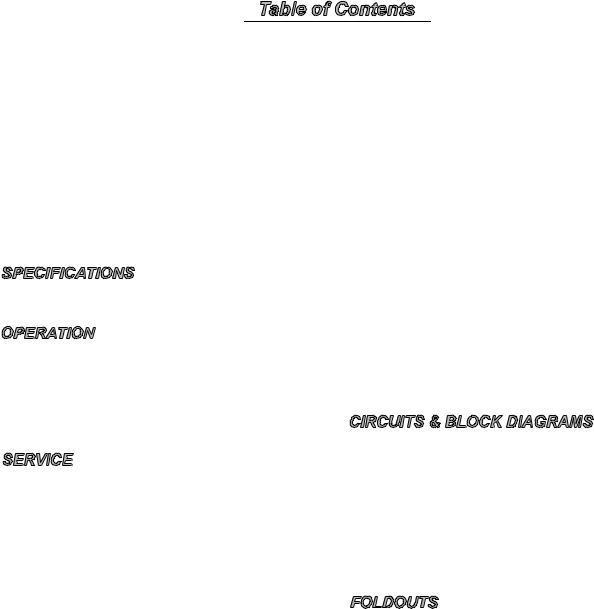
Important Safety Notice . . . . . . . . . . . . . . . . . . 2
Safety Precautions . . . . . . . . . . . . . . . . . 2
General Guidelines. . . . . . . . . . . . . . . . . 2
Leakage Current Cold Check . . . . . . . . . 2
X-ray Radiation. . . . . . . . . . . . . . . . . . . . 2
Horizontal Oscillator
Disable Circuit Test . . . . . . . . . . . . . 2
Service Notes. . . . . . . . . . . . . . . . . . . . . . . . . . . 4
Leadless Chip Component
(surface mount) . . . . . . . . . . . . . . . . 4 Component Removal . . . . . . . . . . . . . . . 4 Chip Component Installation . . . . . . . . . 4 How to Replace Flat-IC . . . . . . . . . . . . . 4 Horizontal Oscillator Disable Circuit . . . . 5
Receiver Feature Table . . . . . . . . . . . . . . . . . . . 6
Location of Controls (Receiver) . . . . . . . . . . . . 7
Quick Reference Control Operation . . . . 7
Quick Reference. . . . . . . . . . . . . . . . . . . 7
Control Operation . . . . . . . . . . . . . . . . . . 7
Location of Controls (Remote) . . . . . . . . . . . . . 8
Disassembly for Service . . . . . . . . . . . . . . . . . . 9
Back Cover . . . . . . . . . . . . . . . . . . . . . . . 9 A-Board - Main Chassis . . . . . . . . . . . . . 9 L-Board - CRT Output . . . . . . . . . . . . . . 9 Speakers . . . . . . . . . . . . . . . . . . . . . . . . 9 Keyboard Push Button Assembly . . . . . . 9 Disassembly for CRT Replacement . . . . 9 CRT Replacement . . . . . . . . . . . . . . . . . 9 Back Cover Removal . . . . . . . . . . . . . . 11
Chassis Service Adjustment Procedures . . . 12
140.0V B+ Voltage Confirmation . . . . . 12
Source Voltage Chart . . . . . . . . . . . . . . 12
High Voltage Check . . . . . . . . . . . . . . . 12
Purity and Convergence Procedure . . . . . . . 13
When the CRT or the Yoke is Replaced 13 Initial Center Static Convergence . . . . . 14 Purity Adjustment . . . . . . . . . . . . . . . . . 14 Dynamic Corvergence Adjustment . . . . 14 DY(YHC, YV, XV) Adjustment . . . . . . . 14 Permalloy Convergence Corrector
Strip (Part No. 0FMK014ZZ) . . . . . 15 DAF Adjustment . . . . . . . . . . . . . . . . . . 15
Serviceman Mode (Electronic Controls) 17
Exiting the Serviceman Mode. . . . . . . . 17
Entering Serviceman
Mode (Back-Open Method) . . . . . . 23
Instructional Flow Chart for
Serviceman Mode . . . . . . . . . . . . . . . . . . . 24
Service Adjustments
(Electronic Controls). . . . . . . . . . . . . . . . . 27
Sub-Contrast Adjustment . . . . . . . . . . . 27
Sub-Brightness (B02) . . . . . . . . . . . . . . 27
Tint/Color Adjustment . . . . . . . . . . . . . . 27
PIP Sub-Contrast Adjustment (P03) . . . 28
Color Temperature Adjustment. . . . . . . 28
Complete Adjustment . . . . . . . . . . . . . . 28
Horizontal Centering (D00). . . . . . . . . . 29
E-W PCC Adjustment (D0C). . . . . . . . . 29
Corner PCC Adjustment (D0B). . . . . . . 29
H-Size Adjustment (D0D) . . . . . . . . . . . 29
V-Size and V-Position Adjustment
(D01 & D06) . . . . . . . . . . . . . . . . . . 29
V-Linearity Adjustment (D03) . . . . . . . . 29
V-Correction Adjustment (D02). . . . . . . 30
MTS Circuit Adjustments . . . . . . . . . . . 30
Input Level Adjustment (M00). . . . . . . . 30
Stereo Separation Adjustment
(M01 & M02) . . . . . . . . . . . . . . . . . 30
Clock Adjustment (S07) . . . . . . . . . . . . 31
Service Adjustments
(Mechanical Controls) 31
Focus (part of T551) . . . . . . . . . . . . . . . 31
Audio Signal Path Block Diagram . . . . . . . . . 32
Video Signal Path Block Diagram . . . . . . . . . 33
IIC Connection . . . . . . . . . . . . . . . . . . . . . . . . . 34
Description of Connectors . . . . . . . . . . . . . . . 35
IC101 IN/OUT Pins and Functions (VCJ) . . . . 36
Component Identification . . . . . . . . . . . . . . . . 37
Parts List . . . . . . . . . . . . . . . . . . . . . . . . . . . . . 40
Schematics, Voltages and waveforms
L-Board Voltages,
PCB & schematics . . . . . . . . . . . . . . . . . 53 A-Board (Left Portion) . . . . . . . . . . . . . . . . . 54 A-Board (Right Portion). . . . . . . . . . . . . . . . 55 A-Board PCB. . . . . . . . . . . . . . . . . . . . . . . . 56 A-Board Voltages . . . . . . . . . . . . . . . . . . . . 57 D-Board schematics . . . . . . . . . . . . . . . . . . 58 D-Board PCB & voltages. . . . . . . . . . . . . . . 59 G-Board schematics . . . . . . . . . . . . . . . . . . 60 G-Board PCB & voltages . . . . . . . . . . . . . . 61 A-Board Waveforms . . . . . . . . . . . . . . . . . . 62
- 3 -
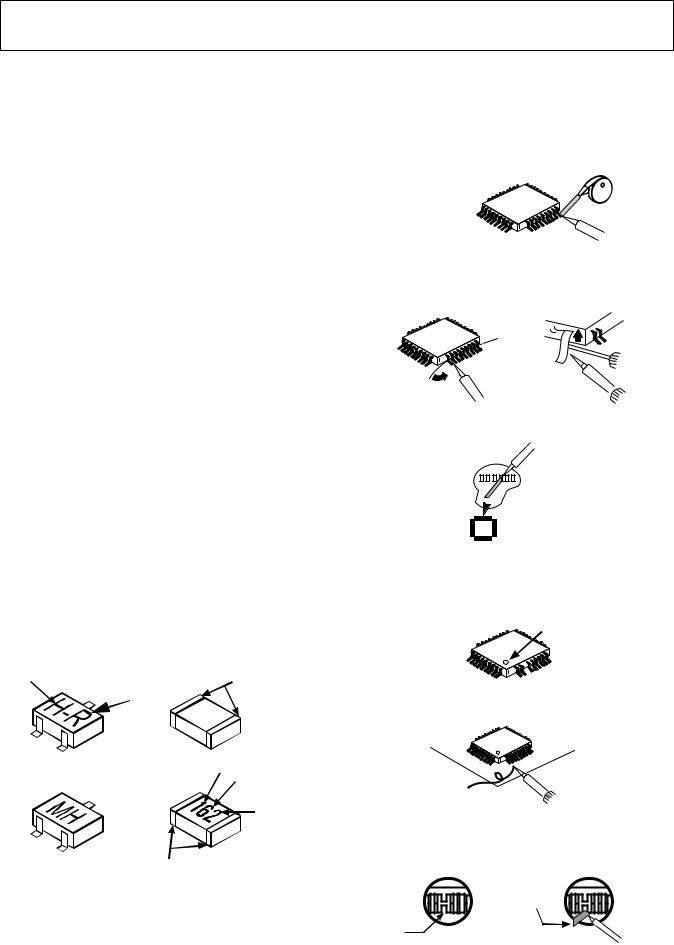
Service Notes
Note: These components are affixed with glue. Be careful not to break or damage any foil under the component or at the pins of the ICs when removing. Usually applying heat to the component for a short time while twisting with tweezers will break the component loose.
Leadless Chip Component (surface mount)
Chip components must be replaced with identical chips due to critical foil track spacing. There are no holes in the board to mount standard transistors or diodes. Some chips capacitor or resistor board solder pads may have holes through the board, however the hole diameter limits standard resistor replacement to 1/8 watt. Standard capacitor may also be limited for the same reason. It is recommended that identical components be used.
Chip resistor have a three digit numerical resistance code - 1st and 2nd significant digits and a multiplier. Example: 162 = 1600 or 1.6kΩ resistor, 0 = 0Ω (jumper). Chip capacitors generally do not have the value indicated on the capacitor. The color of the component indicates the general range of the capacitance.
Chip transistors are identified by a two letter code. The first letter indicates the type and the second letter, the grade of transistor.
Chip diodes have a two letter identification code as per the code chart and are a dual diode pack with either common anode or common cathode. Check the parts list for correct diode number.
Component Removal
1.Use solder wick to remove solder from component end caps or terminal.
2.Without pulling up, carefully twist the component with tweezers to break the adhesive.
3.Do not reuse removed leadless or chip components since they are subject to stress fracture during removal.
Chip Component Installation
1.Put a small amount of solder on the board soldering pads.
2.Hold the chip component against the soldering pads with tweezers or with a miniature alligator clip and apply heat to the pad area with a 30 watt iron until solder flows. Do not apply heat for more than 3 seconds.
TYPE |
Chip Components |
SOLDER |
|
|
GRADE |
|
CAPS |
|
|
|
|
|
c |
|
|
b |
|
|
|
|
e |
CAPACITOR |
|
|
TRANSISTOR |
|
|
1ST DIGIT |
2ND DIGIT |
|
COMMON
CATHODE
MULTIPLIER =1600 = 1.6k
ANODES |
SOLDER |
|
CAPS |
MH DIODE |
RESISTOR |
|
How to Replace Flat-IC
- Required Tools -
• |
Soldering iron |
• |
De-solder braids |
• |
Iron wire or small awl |
• |
Magnifier |
1.Remove the solder from all of the pins of a Flat-IC by using a de-solder braid.
De-Solder
Braid
Flat-IC
2.Put the iron wire under the pins of the Flat-IC and pull it in the direction indicated while heating the pins using a soldering iron. A small awl can be used instead of the iron wire.
Iron
Wire
Awl
|
Soldering |
Soldering |
Pull |
Iron |
|
|
Iron |
|
|
|
3.Remove the solder from all the pads of the Flat-IC by using a de-solder braid.
Soldering
Iron
De-Solder
Braid
Flat IC
4.Position the new Flat-IC in place (apply the pins of the Flat-IC to the soldering pads where the pins need to be soldered). Properly determine the positions of the soldering pads and pins by correctly aligning the polarity symbol.
Polarity Symbol
 .....
.....
123
5.Solder all pins to the soldering pads using a fine tipped soldering iron.
Solder |
Soldering |
|
Iron |
||
|
6.Check with a magnifier for solder bridge between the pins or for dry joint between pins and soldering pads. To remove a solder bridge, use a de-solder braid as shown in the figure below.
|
De-Solder |
|
|
Braid |
|
Solder |
Soldering |
|
Bridge |
||
Iron |
||
|
- 4 -

Service Notes (Continued)
IMPORTANT: To protect against possible damage to the solid state devices due to arcing or static discharge, make certain that all ground wires and CTR DAG wire are securely connected.
CAUTION: The power supply circuit is above earth ground and the chassis cannot be polarized. Use an isolation transformer when servicing the Receiver to avoid damage to the test equipment or to the chassis.
Connect the test equipment to the proper ground  () or (
() or ( 

 ) when servicing, or incorrect voltages will be measured.
) when servicing, or incorrect voltages will be measured.
WARNING: This Receiver has been designed to meet or exceed applicable safety and X-ray radiation protection as specified by government agencies and independent testing laboratories.
To maintain original product safety design standards relative to X-ray radiation and shock and fire hazard,
parts indicated with the symbol  on the schematic must be replaced with identical parts. Order parts from the manufacturer’s parts center using the parts numbers shown in this service manual, or provide the chassis number and the part reference number.
on the schematic must be replaced with identical parts. Order parts from the manufacturer’s parts center using the parts numbers shown in this service manual, or provide the chassis number and the part reference number.
For optimum performance and reliability, all other parts should be replaced with components of identical specification.
Horizontal Oscillator Disable Circuit
This chassis employs a special circuit to protect against excessive high voltage and beam current. If, for any reason, the high voltage and beam current exceed a predetermined level this protective circuit activates and detunes the horizontal oscillator that limits the high voltage. The over-voltage protection circuit is not adjustable. However, if components indicated by the
symbol  on the schematic in either the horizontal sweep system or the over-voltage protection circuit itself are changed, the operation of the circuit should be checked using the following procedure:
on the schematic in either the horizontal sweep system or the over-voltage protection circuit itself are changed, the operation of the circuit should be checked using the following procedure:
Equipment needed to check the disabled circuit:
1.DC Ammeter
2.High Voltage Meter (0- 50kV electrostatic)
3.Variac or Isolation Transformer
4.HHS Jig (See Fig. 2)
Preparation
1.Connect Receiver to AC 120 Volts. Do not turn ON.
2.Connect HIGH VOLTAGE meter to 2nd anode (H.V. button). Note: Use cold ground( 

 ) for negative lead.
) for negative lead.
3.Connect the ammeter serial from the flyback anode lead to the picture tube anode socket.
4.Prepare HHS jig to be connected between TPD50 and TPD51 as shown in Fig. 2.
Procedure:
1.Open Connector A17.
2.Turn power ON and Apply a monoscope pattern.
3.Set current within 50-100μΑ by changing the picture and bright controls.
4.Turn power OFF.
5.Connect HHS jig between TPD50 and TPD51 (VR should be turn fully clockwise).
6.Turn power on.
7.Turn slowly the variable resistor to increase the current until the horizontal sync frequency abruptly increases indicating that the horizontal frequency is
just beginning to pull out of sync. Maintain the current within 50-100μΑ by changing the picture and bright controls
8.Observe the High Voltage meter. HIGH VOLTAGE should read less than 40.2kV.
9.Turn power OFF, Remove HHS jig, HV meter, ammeter and connect A17 connector.
10.Turn Power ON. Reset Picture and Brightness controls. Confirm B+ 140V±1.5V with 120V AC applied.
11.IF HIGH VOLTAGE IS NOT WITHIN THE SPECIFIED LIMIT THE CAUSE MUST BE DETERMINED BEFORE THE RECEIVER IS RETURNED TO THE OWNER.
TPD50 100Ω 1KΩ TPD51
Figure 2. HHS Jig
- 5 -

Receiver Feature Table
|
|
|
|
|
|
|
|
|
FEATURE\MODEL |
CT-32SX31E/UE/CE |
|
CT-36SX31E/UE/CE |
|
||
|
|
|
|
|
|
|
|
|
|
|
|
|
|
|
|
|
Chassis |
|
|
NA8ML |
|
||
|
|
|
|
|
|
|
|
|
Tunning system |
|
|
96K |
|
|
|
|
|
|
|
|
|
|
|
|
# of channels |
|
|
181 |
|
|
|
|
|
|
|
|
|||
|
Menu language |
|
Eng/Span/Fr |
|
|||
|
|
|
|
|
|
|
|
|
Closed Caption |
|
|
X |
|
|
|
|
|
|
|
|
|
||
|
V-Chip (USA/CANADA) |
|
X |
|
|
||
|
|
|
|
|
|
|
|
|
2RF |
|
|
X |
|
|
|
|
|
|
|
|
|||
|
Remote Model # |
|
EUR511500 |
|
|||
|
|
|
|
|
|
||
|
Picture tube |
|
|
AMEC |
|
||
|
|
|
|
|
|
||
|
Comb Filter |
|
|
3 DIG |
|
||
|
|
|
|
|
|
|
|
|
VM |
|
|
X |
|
|
|
|
|
|
|
|
|
|
|
|
V/A norm |
|
|
X |
|
|
|
|
|
|
|
|
|
|
|
|
Color Temp |
|
|
X |
|
|
|
|
|
|
|
|
|
|
|
|
MTS/SAP/DBX |
|
|
X |
|
|
|
|
|
|
|
|
|
||
|
BASS/BL/TRE Control |
|
X |
|
|
||
|
|
|
|
|
|
|
|
|
AI Sound |
|
|
X |
|
|
|
|
|
|
|
|
|
|
|
|
Surround |
|
|
X |
|
|
|
|
|
|
|
|
|||
|
SPATIALIZER/BBE |
|
BBE |
|
|||
|
|
|
|
||||
|
Built-in audio power |
10W/CH (10%) |
|
||||
|
|
|
|
|
|
|
|
|
# of speakers |
|
|
2 |
|
|
|
|
|
|
|
|
|
||
|
A/V in (rear/front) |
|
|
3(2/1) |
|
||
|
|
|
|
|
|
||
|
S-VHS Input (rear/front) |
|
1/1 |
|
|
||
|
|
|
|
|
|
|
|
|
Component Input |
|
|
1 |
|
|
|
|
(Y,Pb,Pr) |
|
|
|
|
||
|
|
|
|
|
|
|
|
|
|
|
|
|
|
|
|
|
Audio Out |
|
|
F,V |
|
|
|
|
(FAO: F, VAO: V) |
|
|
|
|
||
|
|
|
|
|
|
|
|
|
|
|
|
|
|
|
|
|
EPJ/HPJ/MISC |
|
|
HPJ |
|
|
|
|
|
|
|
|
|
|
|
|
Dimensions |
mm |
667.3x810x568 |
|
|
747x936x610.5 |
|
|
(WxDxH) |
in |
26.52x32.4x22.72 |
|
29.88x37.44x24.42 |
|
|
|
|
|
|
|
|
|
|
|
Weight (kg/lbs) |
|
74.8/164.56 |
|
|
98.5/216.7 |
|
|
|
|
|
|
|
||
|
Power source (V/Hz) |
|
120/60 |
|
|||
|
|
|
|
|
|||
|
Anode voltage |
|
31.0kV ± 1.0kV |
|
|||
|
|
|
|
|
|
||
|
Video input jack |
|
1Vp-p |
75Ω, phono jack |
|
||
|
Audio input jack |
|
500mV RMS 47kΩ |
|
|||
|
|
|
|
|
|
|
|
|
A-Board TNP2AH026 |
AB |
|
|
NIL |
|
|
|
|
|
|
|
|
|
|
|
G-Board TNPA1670 |
|
AC |
|
|
||
|
|
|
|
|
|
||
|
L-Board TNPA1673 |
|
AB |
|
|
||
|
|
|
|
|
|
|
|
|
D-Board TNP2AH027 |
AB |
|
|
NIL |
|
|
|
|
|
|
|
|
|
|
|
|
|
|
|
|
|
|
Table 1. Receiver Features
Specifications are subject to change without notice or obligation. Dimensions and weights are approximate.
- 6 -
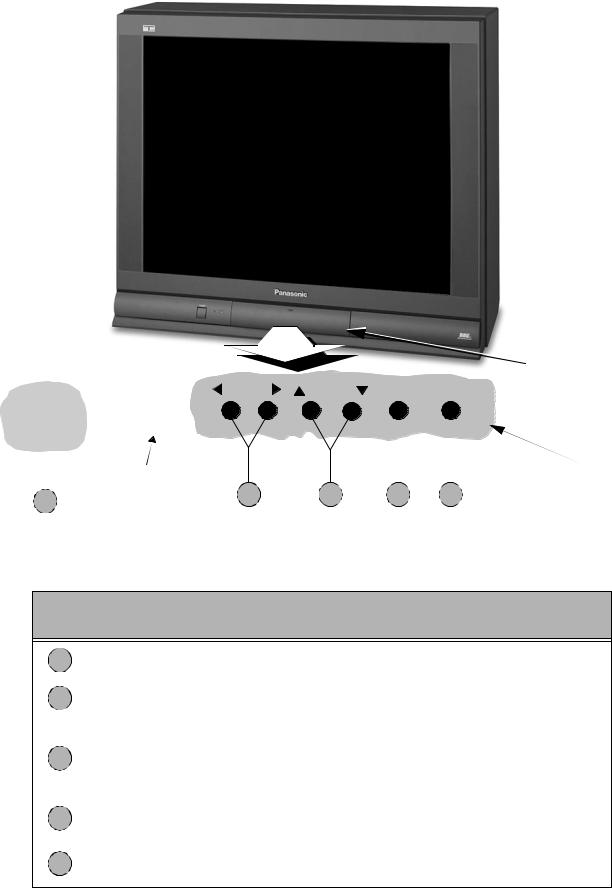
Location of Controls (Receiver)
Front A/V Jacks
VOLUME |
CHANNEL ACTION TV/VIDEO |
POWER |
|
|
|
|
|
|
|
|
|
|
|
Controls Inside |
|
|
|
|
|
|
|
|
|
|
|
||
|
|
|
|
|
|
|
|
|
|
||
|
|
Remote Control |
|
|
|
|
|
||||
|
|
Sensor |
2 |
3 |
4 |
5 |
front door |
||||
1 |
|||||||||||
|
|
|
|
|
|
|
|
|
|||
Figure 3. Location of Controls (Receiver).
Quick Reference Control Operation
Quick Reference
Control Operation
1Power Button - Press to turn ON or OFF.
2Volume Buttons - Press to adjust Sound Level, or to adjust Audio Menus, Video Menus, and select operating features when menus are displayed
Channel Buttons - Press to select programmed channels. Press to highlight desired
3features when menus are displayed. Also use to select Cable Converter box channels after programming Remote Control Infra-red codes (the TV/AUX/CABLE switch must be set in CABLE position).
4Action Button - Press to display Main Menu and access On Screen feature and Adjustment Menus.
5TV/Video Button - Press to select TV or Video Input.
-7 -
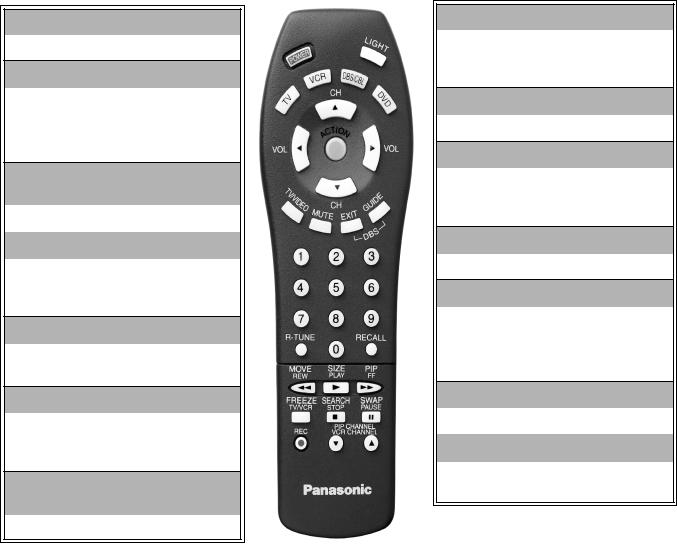
Location of Controls (Remote)
POWER Button
Press to turn ON and OFF.
MUTE Button
Press to mute sound.
A second press resumes sound. Press also to access and delete Closed Caption display.
VCR, DVD, LD/CD, AUX, TV, CBL,
DBS, RCVR
Component function buttons
VOL (volume) Buttons
Press to adjust TV sound level. Use with Channel buttons to navigate in menus.
R-TUNE (Rapid Tune) Button.
Press to switch to the previous channel.
ACTION Button
Press to display Main Menu and access or exit On Screen features and Adjustment Menus.
REW, PLAY, FF, TV/VCR, STOP, PAUSE, REC, VCR CHANNEL
Component function buttons.
Figure 4.
MULTI Button
Programmable button that can operate up to seven (7) functions at once
TV/VIDEO Button
Press to select TV or Video input.
CH (channel) Buttons
Press to select channels. Use with volume buttons to navigate in menus.
DBS EXIT, DBS GUIDE
DBS function buttons.
RECALL Button
Press to display Time, status of Sleep Timer, Channel, Video mode and Channel Caption (Station Identifier).
OPEN/CLOSE, SLOW, STILL
DVD function buttons.
“0” - “9”
Press numeric keypad to select any channel.
EUR511500
Location of Controls (Remote).
- 8 -
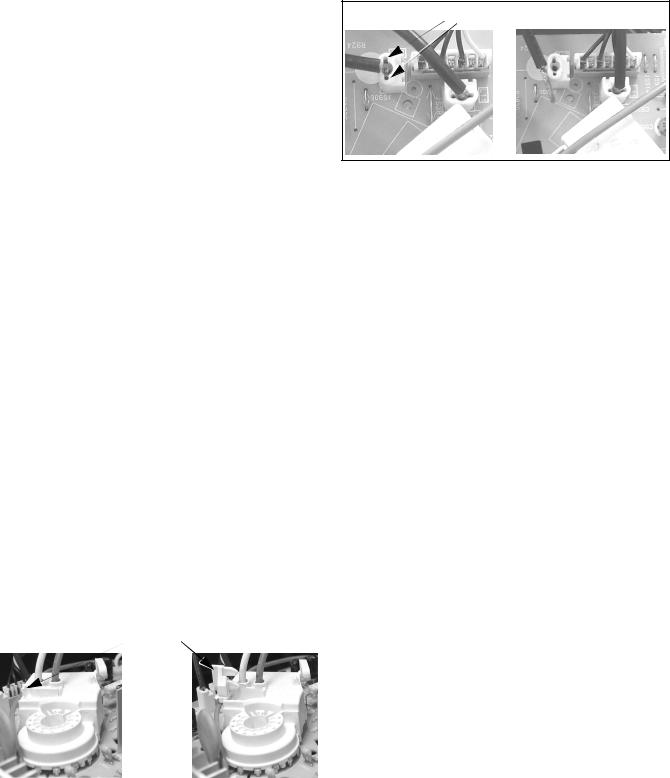
Disassembly for Service
Back Cover
Remove all the screws marked with an arrow(  ) from the back of the Receiver.
) from the back of the Receiver.
Note: Screw configuration, type, and number of screws vary depending on the model of the Receiver serviced and the application; various models are covered in this Manual. Use same hardware when reassembling the receiver.
•4 screws at the top edge of the Receiver.
•4 screw by the A/V jacks.
•1 screw by the antenna jacks.
•1 screw at each lower corner of the Receiver.
•1 screw by the retainer plate of the AC power cord.
To release screen GND cables from L-Board L11 & L12 connectors, insert a wire in both sides of connector and pull upwards the cable, then remove the wire
(See Fig. 6)
Insert wire
Pull cable upwards
Figure 6. L-Board Screen GND cables release
A-Board - Main Chassis
The A-Board assembly rest on a chassis tray along with the D-Board. Slide chassis tray out. Gently lift tray and pull out. Disconnect plug connectors; release wire ties and holders as required for complete chassis removal.
1.A & D-Boards are secured to the chassis tray with five screws.
2.The A-Board is mated to the D-Board by three flexible connectors: A1, A2 & A3 (G1, G2 & G3 on the G-Board, respectively). To remove either boards, unplug the connectors on the A-Board.
Note: Some tie-wraps that secure the wire dressings may need to be unfastened for chassis removal.
L-Board - CRT Output
Plugs into the socket on the CRT neck.
To remove this board, first unplug the board from the CRT neck, then disconnect L1, L2 & L3 connectors, to disconnect the focus F1(Red Cable) & F2(White Cable) cables, pull the tab and release the cables, finally disconnect the screen cable from the D-Board Fly-Back.
To reinsert back the cables, remember the original position of cables, F1(red cable) goes to A on the CRT socket and F2(white cable) goes to B on the CRT socket.
Press tab |
|
|
leftward to |
Pull cables |
|
release cables |
||
upwards |
||
|
||
|
|
Speakers
Speaker is secured to the cabinet’s front with 4 screws.
Keyboard Push Button Assembly
Fastened to the inside of the cabinet front.
Disassembly for CRT Replacement
1.Discharge the CRT as instructed in the Safety Precautions (see page 2).
2.Disconnect the yoke (DY) plug, degaussing coil (DEG) plug and the CRT 2nd anode button from the board.
3.Remove the L-Board from the CRT socket and unplug the black wires (CRT dag ground) L11 & L12.
4.Lift the Main Chassis (A-Board) and all mounted boards completely out with the CRT Board attached.
CRT Replacement
1.Perform Disassembly for CRT Replacement procedure.
2.Insure that the CRT H.V. Anode button is discharged before handling the CRT. Read the Safety Precautions (see page 2) on handling the picture tube.
3.Remove the components from the CRT neck and place the cabinet face down on a soft pad.
4.Note the original order for the CRT mounting hardware as they are remove from the CRT mounting brackets at each corner of the CRT.
5.Remove the CRT with the degaussing coil and the dag ground braid attached.
Note: After servicing the receiver, remember to dress the cables, as shown above.
Figure 5. F1 & F2 cables release
- 9 -
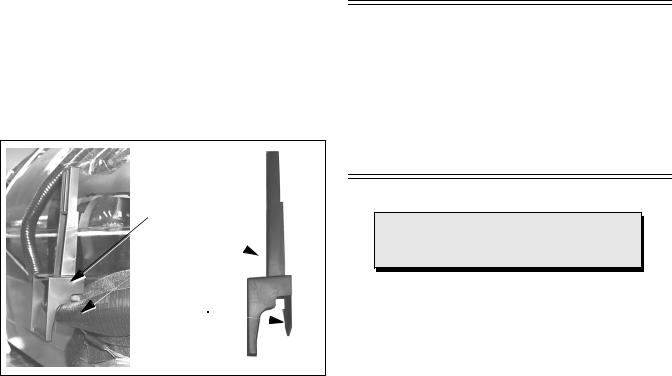
Disassembly for Service (Continued)
Note: To remove the four brackets holding the degauss coil from the corners of the CRT, first remove the CRT from the cabinet, then remove the Brackets by pressing the tab on the bracket and pull upwards. These Brackets are included in the Degauss Coil Kit, for part number, please see parts list section (See Fig. 7).
Degaussing
Coil
Bracket
Degaussing
Coil
Press tab
Then Pull
Upwards
Figure 7. Brackets removal
6.Note the original locations and mounting of the degaussing coil and the dag ground assembly to insure proper reinstallation on the replacement CRT.
To remove and remount the degaussing coil:
The degaussing coil is held in place by clampers fastened to the CRT corner ears. These clampers must be installed onto the replacement CRT prior to mounting the degaussing coil.
To remove and remount the dag ground braid: a.Unhook the coil spring from the bottom corners
of the CRT ears.
b.Release the braid loop from the upper corners of the CRT ears.
7.Mount the dag ground braid on the replacement CRT. Position the degaussing coil with new ties. Dress coil as was on the original CRT.
8.Replace the components on CRT neck and reinstall into cabinet. Verify that all ground wires and circuit board plugs get connected.
Note: Reuse all the clampers and mounting brackets from the degaussing coil and screen, and when remounting the degaussing coil assure that is not touching the speakers, this can be done by placing some tape (See Fig. 7), this may cause mask vibration. The mounting brackets and clampers are not supplied with the replacements.
Important Notice:
When ordering the CRT, please order CRT and CRT KIT also. Please see parts list section for part numbers
- 10 -
